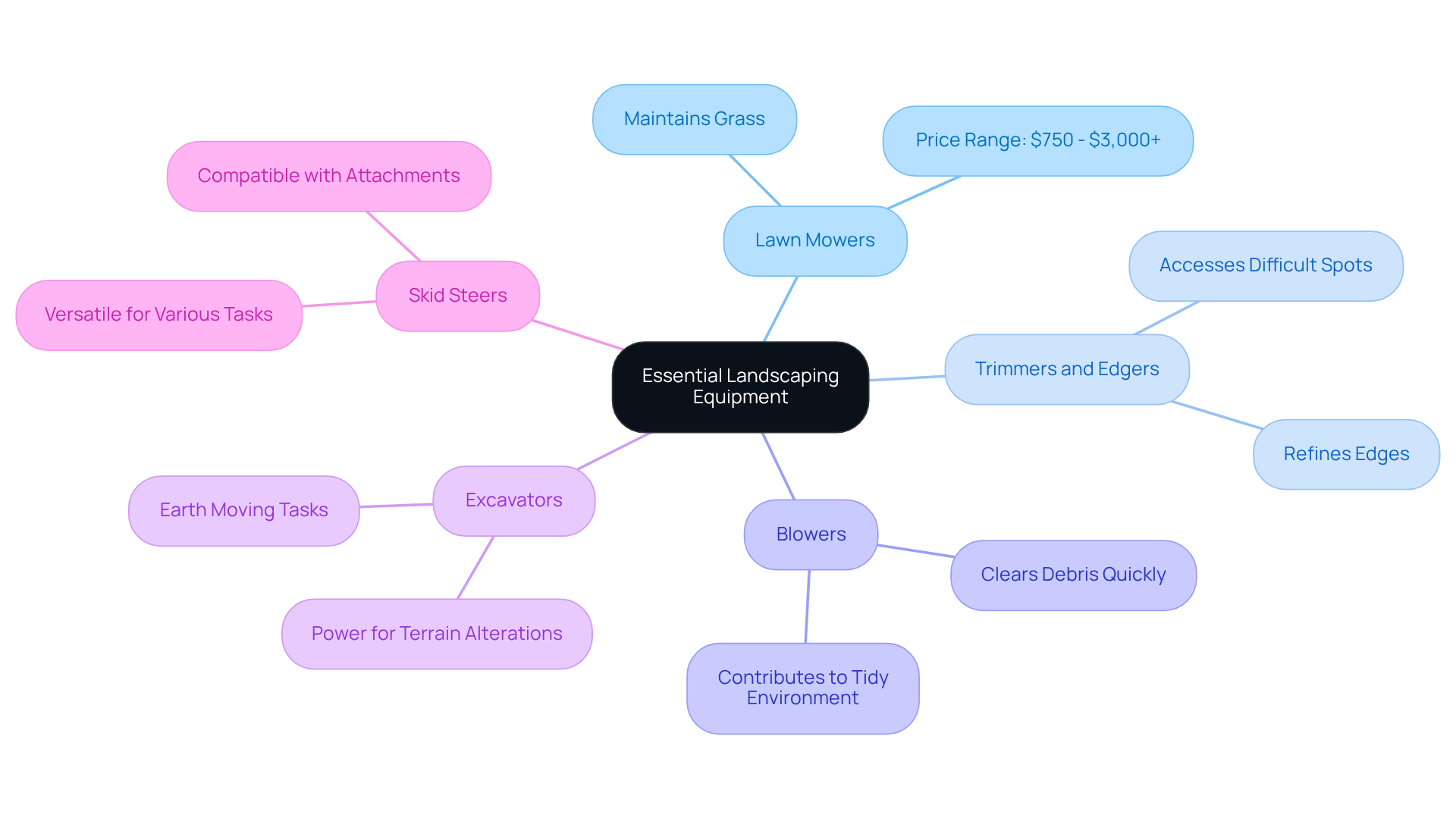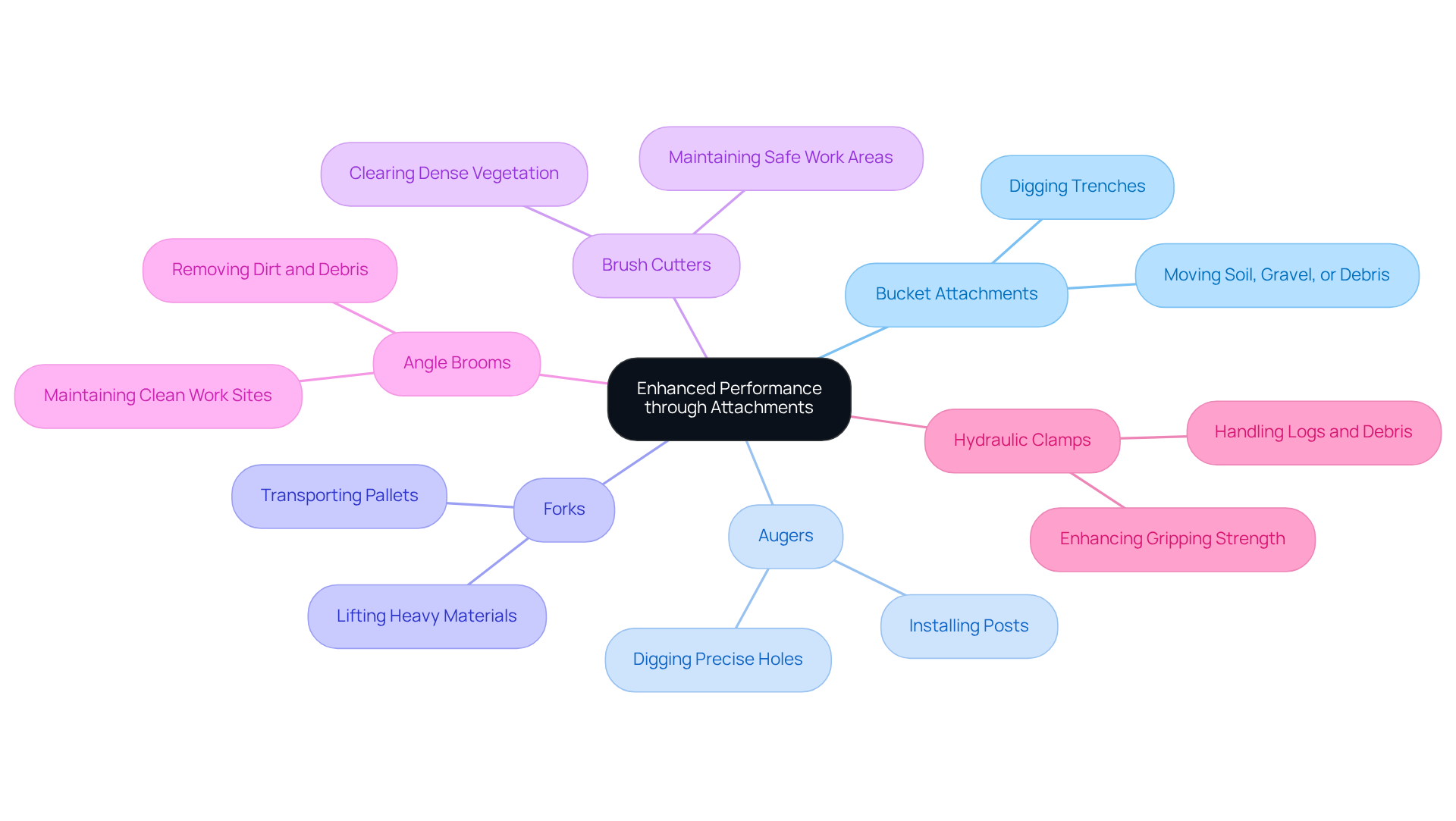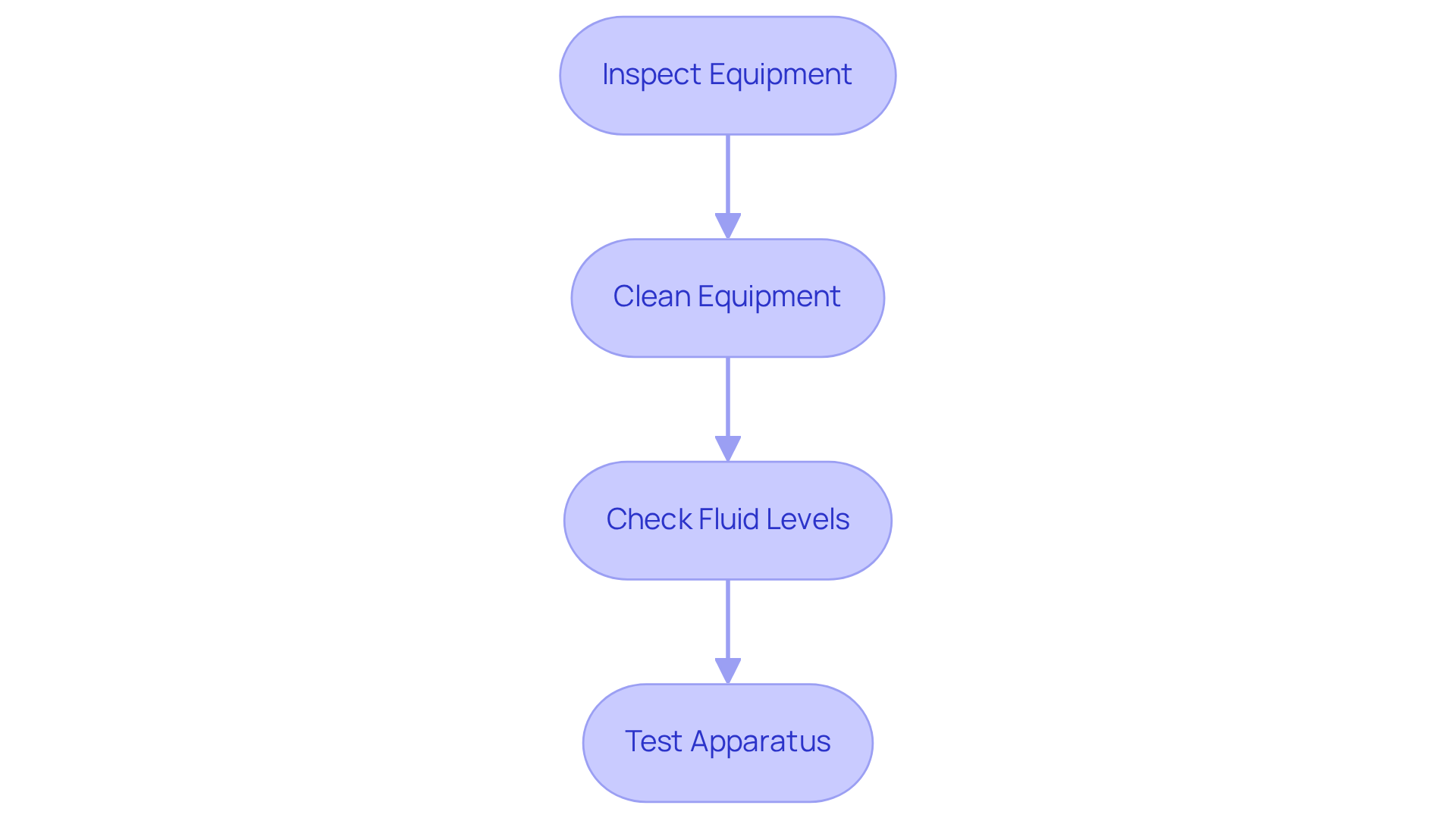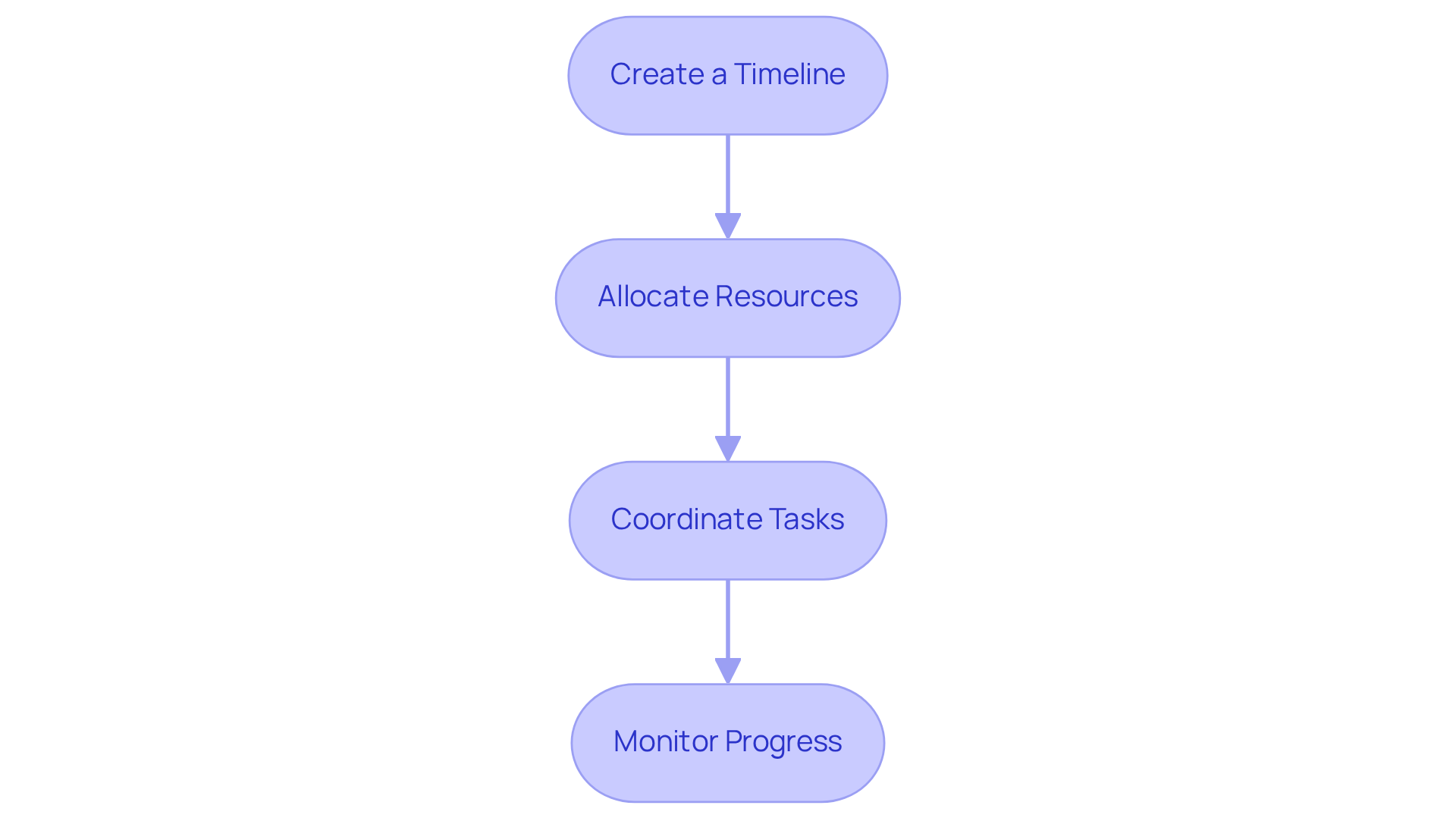Overview
Maximizing productivity in landscaping equipment rental begins with the careful selection of essential tools, diligent maintenance of equipment, and strategic project planning. This article emphasizes the significance of specific tools tailored for various tasks, highlighting how these choices can enhance operational efficiency.
Furthermore, routine maintenance practices are crucial, as they not only prolong the lifespan of equipment but also ensure optimal performance. Effective planning methods are essential, as they guarantee timely project completion and the efficient use of resources.
By focusing on these key aspects, businesses can significantly improve their productivity and service quality.
Key Highlights:
- Essential landscaping tools include lawn mowers, trimmers, blowers, excavators, and skid steers, each serving specific purposes.
- Electric equipment is preferred for its lower maintenance costs and reduced operating hours, promoting sustainable practises.
- Over 54% of homeowners engage in DIY lawn care, indicating a strong interest in gardening activities.
- Key attachments for landscaping equipment include buckets, augers, forks, brush cutters, angle brooms, and hydraulic clamps, enhancing performance for various tasks.
- Regular maintenance steps include inspecting, cleaning, checking fluid levels, and testing equipment to prevent breakdowns and extend machinery lifespan.
- Effective project planning involves creating timelines, allocating resources, coordinating tasks, and monitoring progress to ensure projects stay on schedule and within budget.
Introduction
Maximizing productivity in landscaping equipment rental transcends merely possessing the right tools; it necessitates a strategic approach to the selection, maintenance, and effective utilization of equipment. As the landscaping industry evolves, staying abreast of the latest trends and best practices is crucial for enhancing efficiency and achieving superior outcomes in both residential and commercial projects.
With a plethora of options at one's disposal, how can one ensure they are making optimal choices tailored to their specific needs? This article explores essential equipment, effective planning, and maintenance strategies that can elevate outdoor projects into successful ventures.
Identify Essential Landscaping Equipment for Your Project
Identifying the essential tools is crucial for maximizing productivity in landscaping equipment rental for your outdoor work. EZ Equipment Rental provides a comprehensive selection of tools designed to meet your needs, including:
- Lawn Mowers: These are essential for maintaining grass and ensuring a neat appearance, with prices ranging from $750 to over $3,000 for professional-grade models.
- Trimmers and Edgers: Ideal for refining edges and accessing difficult spots, they significantly enhance the overall appearance of outdoor projects.
- Blowers: These tools are useful for quickly clearing debris and leaves, contributing to a tidy work environment.
- Excavators: Essential for larger tasks involving earth moving, they supply the power required for substantial alterations to the terrain.
- Skid Steers: Versatile machines that can manage various tasks with the appropriate attachments, making them a staple in many gardening operations.
When evaluating the specific needs of your project, consider factors such as the size of the area, the type of outdoor work (e.g., planting, grading), and any special requirements. For example, electric equipment is gaining traction due to its lower maintenance costs—estimated at 35% less—and reduced operating hours, which can be cut by up to 45% due to decreased idling. This trend reflects a growing preference for sustainable practices in outdoor design, including xeriscaping and grass alternatives, which are increasingly popular among eco-conscious homeowners.
Furthermore, it is worth noting that 54.07% of homeowners engage in DIY lawn care, indicating significant involvement with gardening activities. To ensure you don’t miss any essential items, create a checklist of the tools required. As the gardening sector evolves, staying updated on the latest trends and tools will assist you in maximizing productivity in landscaping equipment rental while executing successful tasks effectively.

Choose the Right Attachments for Enhanced Performance
Selecting the right accessories is crucial for maximizing productivity in landscaping equipment rental and ensuring the efficiency of your outdoor equipment. In 2025, several attachments stand out for their specific applications:
- Bucket Attachments: Essential for moving soil, gravel, or debris efficiently, these attachments are a staple for any landscaping project.
- Augers: Perfect for digging precise holes for planting trees or installing posts, augers save both time and effort compared to manual digging methods.
- Forks: Ideal for lifting and transporting heavy materials, forks significantly enhance material handling capabilities on job sites.
- Brush Cutters: Effective for clearing dense vegetation, these tools ensure your work area remains safe and accessible.
- Angle Brooms: Perfect for maintaining clean work sites, angle brooms efficiently remove dirt, debris, and trash from various surfaces.
- Hydraulic Clamps: These attachments enhance gripping strength for compact excavators, making them suitable for handling materials like logs and debris.
When renting equipment, it is advisable to consult with EZ Equipment Rental to ensure you select the most suitable accessories for your specific tasks. This strategic approach not only boosts performance but also contributes to maximizing productivity in landscaping equipment rental for your outdoor initiatives. As Richard Branson aptly noted, learning through doing is key; selecting the right tools and attachments is a vital step in that process.

Implement Routine Maintenance and Preparation for Equipment
To ensure the success of your landscaping project, regular maintenance and preparation of your rental tools are paramount for maximizing productivity in landscaping equipment rental. Follow these essential steps:
- Inspect Equipment: Begin with a thorough inspection for any visible damage or signs of wear and tear. Conducting routine evaluations can prevent as much as 50% of unexpected outages, often caused by aging machinery (source: WorkTrek).
- Clean Equipment: It is crucial to remove dirt and debris to maintain optimal performance. Machines that are properly maintained can operate up to 15% more efficiently than those that are neglected (source: Plant Engineering).
- Check Fluid Levels: Ensure that oil, fuel, and hydraulic fluids are at appropriate levels. Regular checks can help avert costly repairs and extend the lifespan of your machinery by 20-40% (source: WorkTrek).
- Test Apparatus: Operate the device to confirm it functions smoothly and efficiently. Testing before use can reveal potential issues early, thus minimizing the risk of delays during your project.
By adhering to these preparation steps, you can effectively mitigate unexpected issues that could hinder your timeline, which is essential for maximizing productivity in landscaping equipment rental and ensuring that your equipment is fully operational when needed.

Plan Your Work Schedule and Optimize Resource Allocation
Efficient planning and resource distribution are crucial for maximizing productivity in landscaping equipment rental during your outdoor endeavors.
- Create a Timeline: Clearly outline the phases of your landscaping endeavor, establishing deadlines for each task. This structured approach helps maintain focus and accountability.
- Allocate Resources: Assess the equipment and personnel required for each phase. Effective resource distribution can significantly contribute to maximizing productivity in landscaping equipment rental. For instance, case studies have shown organizations reducing completion times by 20% through strategic resource management, as evidenced by XYZ Tech Solutions.
- Coordinate Tasks: Schedule tasks in a logical sequence to minimize downtime. Effective communication and coordination among team members ensure that everyone is aligned and working towards common goals.
- Monitor Progress: Regularly review progress against your timeline and make adjustments as needed. Ongoing supervision enables prompt actions, guaranteeing that initiatives remain on schedule and within financial limits. According to PMI, 85% of initiatives remained within budget due to efficient cost-monitoring abilities.
By applying these strategies, you can enhance the efficiency of your landscaping endeavors, which is crucial for maximizing productivity in landscaping equipment rental and achieving successful results. As project managers emphasize, optimizing resource allocation is crucial for achieving project milestones and maximizing overall effectiveness.

Conclusion
Maximizing productivity in landscaping equipment rental is essential for achieving successful outdoor projects. A strategic approach that encompasses careful selection, routine maintenance, and effective planning is vital. Understanding the essential tools for specific projects, choosing the right attachments, and implementing a structured work schedule can significantly enhance efficiency and outcomes in outdoor endeavors.
Identifying necessary equipment such as lawn mowers, trimmers, and excavators is crucial. Selecting appropriate attachments not only improves performance but also ensures that each task is executed with precision. Regular maintenance practices, including inspections and fluid checks, guarantee that rented equipment operates at peak efficiency. Furthermore, careful planning and resource allocation streamline workflows and minimize downtime, leading to a more productive landscaping experience.
Ultimately, embracing these best practices fosters a sustainable approach to outdoor work. As the landscaping industry continues to evolve, staying informed about current trends and leveraging the right equipment transforms challenges into opportunities for growth and creativity in landscaping endeavors. Now is the time to take action—equip yourself with the right tools and strategies to elevate your landscaping projects to new heights.
Frequently Asked Questions
What essential landscaping equipment should I consider for my project?
Essential landscaping equipment includes lawn mowers, trimmers and edgers, blowers, excavators, and skid steers.
What is the purpose of lawn mowers in landscaping?
Lawn mowers are crucial for maintaining grass and ensuring a neat appearance in outdoor spaces.
How do trimmers and edgers contribute to landscaping?
Trimmers and edgers refine edges and access difficult spots, significantly enhancing the overall appearance of outdoor projects.
What role do blowers play in landscaping?
Blowers are useful for quickly clearing debris and leaves, helping to maintain a tidy work environment.
When are excavators necessary in landscaping projects?
Excavators are essential for larger tasks that involve moving earth and making substantial alterations to the terrain.
What are skid steers, and why are they important?
Skid steers are versatile machines that can manage various tasks with the appropriate attachments, making them a staple in many gardening operations.
What factors should I consider when evaluating my landscaping equipment needs?
Consider the size of the area, the type of outdoor work (e.g., planting, grading), and any special requirements for your project.
Why is electric equipment becoming more popular in landscaping?
Electric equipment has lower maintenance costs—estimated at 35% less—and can reduce operating hours by up to 45% due to decreased idling, aligning with sustainable practices.
What trends are influencing landscaping and gardening practices?
There is a growing preference for sustainable practices such as xeriscaping and grass alternatives, which are increasingly popular among eco-conscious homeowners.
How involved are homeowners in DIY lawn care?
Approximately 54.07% of homeowners engage in DIY lawn care, indicating significant involvement with gardening activities.
What can I do to ensure I have all the necessary landscaping tools?
Create a checklist of the tools required for your project to ensure you don’t miss any essential items.




